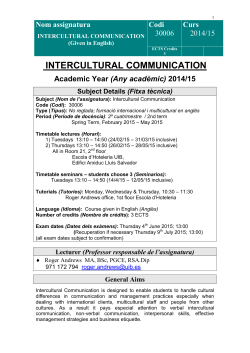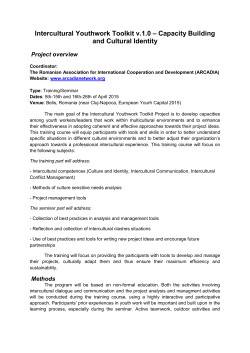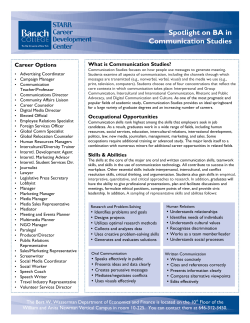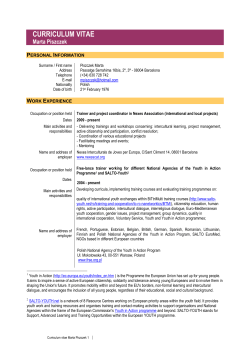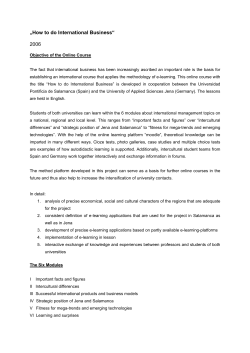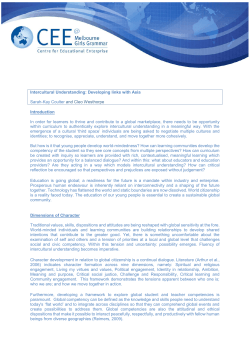
Intercultural Education - Pixel International Conferences
Intercultural Education - Objectives, Values and Perspectives Argentina Chiriac, Liliana Panciuc State University of Medicine and Pharmacy “Nicolae Testemitanu” (Republic of Moldova) argentina.chiriac@usmf.md, liliapanciuc@yahoo.com Abstract The contemporary society is a mobile society characterized by diversity and change. The issue of cohabitation together is increasingly approached in the modern society. We belong to different ethnic groups, various linguistic cultures and religious backgrounds. Given this diversity, coexistence is a must. Intercultural education is one of the basic tools with which members of the society and societies. Intercultural education is a global necessity, a specialized form of education that puts individuals and their cultures in positions of differential treatment, but at the same time they are in positions of equality. It deals with the educational process through the vision of cultural diversity and is focused on cultural interaction phenomena (people, cultures, religions, speakers of different languages, people who have different views and opinions, etc.). The values derived from intercultural education (tolerance, freedom, openness, acceptance of differences, understanding of diversity, pluralism, cooperation) are built into the personalities of the educated subjects through sustained and consistent (systematic) efforts. Intercultural education is a dimension of the new education, which focuses on the values mentioned above. It promotes solidarity of the local community with the international community. Intercultural education refers to the phenomenon of interaction between people, religions, cultures, speakers of different languages who have different opinions and views. This education is fundamental in addressing cultural differences (principles, values, traditions etc.) as well as other differences (gender, social, economic differences, etc.). Intercultural education refers “to education training people able to appreciate different cultures, which are set in a traditional society and therefore able to accept to evolve in contact with these cultures, so that this diversity could become an asset enriching the cultural, social and economic life of the environment " [5]. Intercultural education implies the presence of members of different cultures, namely education of interpersonal relationships. The main objectives of intercultural education are the following: enhancing the efficiency of intercultural relations; increasing tolerance and acceptance towards those who are different; training people to make them perceive, accept and respect diversity for mediating social relations. In various fields some differences can be attested: language of communication; religion; social practices of communication; ways of relating; clothing; diet; leisure traditions, norms and habits; physical appearance and various disabilities etc. This wide range of diversity produces complex cognitive, affective, and behavioral reactions in individuals during the interaction with other individuals perceived as different. Intercultural education requires to be carried out in a different social environment, in which various cultural events can be recorded [1]. Intercultural education is a dimension of education in a global perspective (along with other forms of education: for peace, human rights, sustainable development, education for respect and protection of the environment) which is based on the following values: intercultural values: tolerance, pluralism, accountability and openness to others; openness to the world: solidarity, cooperation and commitment; democracy: equality, peace, freedom, justice. The term intercultural education is a concept in development, having been approached in scientific researches for a long period of time. Researches that have been carried out were related in particular to identification of means of socio-educational integration, due to a growing number of immigrant students [2]. Intercultural education means any systematic effort, in order to develop in the members of the majority groups as in those of the minority groups the following abilities : a better understanding of the situation of culture in modern societies; greater ability to communicate with people of different cultures; attitudes better adapted to the context of different cultures and groups in a given society, thanks in particular to a better understanding of the mechanisms of psycho-social and sociopolitical factors, likely to possess xenophobia and racism; better ability to participate in social interaction, creating identities and common humanity [10]. Intercultural education implies a pedagogical approach to cultural differences, a strategy through which the spiritual specificities or others are taken into account (gender, social or economic differences, etc.), avoiding as much as possible the risks arising from inequal exchanges between cultures or, worse, trends of culture atomization. "Intercultural approach is neither a new science nor a new discipline, but a new methodology that seeks to integrate in the interrogation on the educational space, the data of psychology, anthropology, social sciences, politics, culture and history" [6]. Interculturalism requires understanding, consideration and appreciation of the own culture, as well as respect based on genuine information and arousal of curiosity towards the ethnic culture of others. Interculturality is an action that occurs at the intersection of cultures, not being an end in itself. But it can become an end when unnatural transformations or harmful behaviors are sensed at this level of crossing of cultures. Summarizing the above mentioned ideas, and trying to make a personal definition, we can mention that intercultural education is a complex of principles and practices related to the entire educational environment in all its components, oriented towards shaping through and for cultural diversity, with a direct effect upon knowledge and positive appreciation of cultural differences, promoting equity in education and equalization of opportunities. There are some perspectives on intercultural education. One of these perspectives is solution to conflicts. It is one of the perspectives through which intercultural education was approached. For example: the solution of economic, social, historical conflicts, etc. which alternatively have a cultural component. It is believed that lack of spiritual communication generates and maintains other states of misunderstandings and tension. One of the conditions for management of these states of misunderstanding is the identification and maintenance of some lines of spiritual communication. Intercultural education can be approached from the perspective of conflicts as a solution to racism, intolerance, xenophobia. This education is a very useful tool in combating them. Or, interculturalism is a tool for promoting equal opportunities, the development of democracy, respect for human rights. By educating people in intercultural spirit a series of problems will be avoided and even solved such as tendencies of contempt, denial of values and traditions, and different behaviors. Intercultural education in terms of shaping personal identity comes from the fact that people come into contact with each other, and maintaining social relationships can be quite difficult because we have different modes of action, thought, and feeling. People can develop different strategies in interpersonal relations: either relations of openness or acceptance to other persons or retreat in oneself, protecting culture and personal identity. Intercultural education from the perspective of openness to different values essentially aims to integrate individuals into a dynamic and polymorphic world. This contributes to the development of individuality by valuing individual traits which must be recognized and evolved, thus supporting the society and ensuring the coherence, functionality and solidarity. In this case, we can speak about multicultural education. Multicultural education is intended to build a person's ethnic identity and promote appreciation of others, reduce prejudices and stereotypes, promote cultural pluralism. Differences of the terms multiculturalism and interculturalism are encountered in the literature [3]. The relationship between the dominant culture and subcultures of various groups that coexist in the same space, respect and transmit the core values of the dominant culture – is another approach to interculturalism. In a culture many other subcultures coexist, the culture being the result of dynamic integration of various subcultures and the dominant culture. Subculture may represent the following groups: groups with different religions; members of a generation; people working in the same institution; people with special needs/disabled ones; ethnic minorities. Reference ethnic group is considered the group providing social support to the individual for socialization, psychological support for personal development in a social context in which the society is highly developed and verified by a dominant ethnic group. First, the school must adapt to reality to design learning experiences.The curriculum should be structured so as to interpret the events of ethnic perspectives of an ethnic group. Multiculturalism is a reality of existence in the same space-time horizon of some groups of individuals from many cultures that affirm their specific notes in isolation, usually avoiding contaminations [9]. Interculturality is emerging as a concept having a broad content due to prefix inter, which links to "interaction, sharing, openness, reciprocity, solidarity" [9]. The term intercultural was selected taking into account the polyvalent meaning of the prefix inter as well as (anthropological) meaning of the word culture. Thus, when we say intercultural we mean inevitably interaction, exchange, reciprocity, interdependence and solidarity. We also refer to: recognition of values, lifestyles, symbolic representations to which the human beings relate to, individuals or groups in relation to peers and in understanding of the world, recognizing the interactions that occur at some point between the multiple aspects of the same culture and between different cultures in time and space [8]. Culture is a set of distinctive spiritual characteristics, material and intellectual traits characteristic of a society or social group, embedded in lifestyles, value systems, beliefs and traditions. It has been a central variable in all societies in building and implementing macromodels of change, an indicator of their efficiency and practically the essence of overall development. Analyzing various definitions of culture, we can reveal some of its features: it is not innate, but acquired; culture is shared, it has a collective dimension, thus delimiting the various cultural groups; it is transmitted from one generation to another undergoing changes specific to era it manifests in. This has been termed enculturation by specialists. Culture is in a close connection with value. The latter is assigned special meanings like: it is the result of human consciousness to assign the qualities of an entity or existential state, as a result of a preference, desire or intention; is a situational, relational attribute which settles following human orientation in a transcendental order. The fundamental values underlying intercultural education are respect for human rights and the rule of law. Contemporary society formulates its existential principles based on general human values such as: respect, justice, fairness, dignity, responsibility, empathy and peace. Cultural relativism is a concept according to which any behavior can not be judged only by reference to the social context in which it occurs. Before valuing behaviors of individuals, they will be reported to the cultural background of beliefs and expectations implied by basic cultural environment. The key elements in intercultural education-culture report are: culture and cultural identity which are some dynamic phenomena; all people are carriers of culture and must freely choose identity development; intercultural education aims at interactions, communication, cultural proximity between different carriers of cultures open to all people. Reporting culture to education involves designing education as a project of initiation of human being into cultural values, as a very demanding process of acquiring cultural tools essential in social foundation of human being-personality. One of the main tools through which individuals and societies are ready to be more cautious with the cultural dimension in their existence is intercultural education. Intercultural education deals with the educational process from the vision of cultural diversity and is focused on the phenomenon of cultural interaction (people, cultures, religions, speakers of different languages, people who have different views and opinions, etc.). It has become the need for a pragmatic option for both "majority" who are preparing for the integration of newcomers in multicultural contexts, and for "minority" aimed at preparing future citizens very well integrated socioculturally through best choices in their personal lives. To expand on civic lifestyles and social interaction that strengthen respect for human rights and responsibility in the exercise of personal freedom, the results of intercultural education require pragmatic coherence and temporal perspective. References: [1] Badelau P. Intercultural education. Bulettin du BIE, Paris, nr. 622. UNESCO, 1990. [2] Bernat S. E. Multicultural education. Methodological guidelines. CRDE Foundation, Cluj, 2006 [3] Chiriac A., Guţu V. Intercultural education in higher education. Chişinău, 2013. [4] Ciolan L. Paşi către şcoala interculturală. Centrul Educaţia 2000, Bucureşti, Editura Corint, 2000. [5] Cozma T. A new challenge for education: interculturality. – Iaşi: Polirom, 2001. [6] Cucoş C. Education. Cultural and intercultural dimensions. – Iaşi: Polirom, 2000. [7] Cushner K. International Perspectives on Intercultural Education, Lawrence Erebaum Associates, Mahwah, New Jersey, 1998. [8] Dasen Pierre, Perregaux Christiane, Rey Micheline. Intercultural education. Experience, politics, strategies. – Iaşi: Polirom, 1999. [9] Dasen P., C. Perregaux M. Rey, Tracks for intercultural education and solitary. Iasi: Polirom, 1999. [10]Ouellet, F. (1997). Éducation interculturelle et formation interculturelle. Éléments de problématique. Études ethniques au Canada, Vol. 29, no 2.
© Copyright 2025
